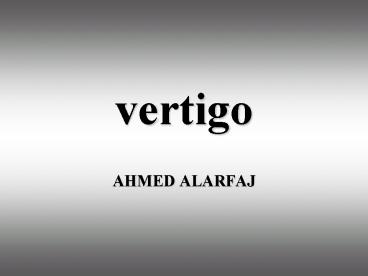vertigo - PowerPoint PPT Presentation
1 / 24
Title:
vertigo
Description:
VERTIGO (illusion of rotational, linear or tilting movement such as 'spinning' ... CALORIC. VESTIBULAR DISORDERS. Meniere's Disease (Endolymphatic. Hydrops) DIAGNOSIS ... – PowerPoint PPT presentation
Number of Views:1365
Avg rating:3.0/5.0
Title: vertigo
1
vertigo
- AHMED ALARFAJ
2
DEFINITION TERMINOLOGIES
3
DEFINITION TERMINOLOGIES
- VERTIGO (illusion of rotational, linear or
tilting movement such as spinning, whirling
or turning of the patient or the surrounding .
DISEQUILBRIUM sensation of instability of the
body positions, walking or standing described as
off balanced or imbalanced.
4
DEFINITION TERMINOLOGIES
- OSCILLOPSIA (inability to focus on objects with
motion, such as reading a sign while walking).
5
DEFINITION TERMINOLOGIES
- LIGHTHEADEDNESS (sense of impending faint,
presyncope). - PHYSIOLOGIC DIZZINESS (motion sickness, height
vertigo),
6
EVALUATION OF THE DIZZY PATIENT
- History
- Dizziness is a term used to describe any of a
variety of sensation that produce spatial
disorientation. - Onset and Duration of Symptoms
7
EVALUATION OF THE DIZZY PATIENT
- History
- Character of Dizziness
- Contributing Factors
- Associated Symptoms
8
PHYSICAL EXAMINATION
- HN and General Physical Exam
- Otoscopy
- Vestibular Testing
- Neurological Exam
9
General Characteristics of Peripheral and Central
Causes of Vertigo
- Characteristic Peripheral Central
- Intensity severe mild
- Fatigability fatigues, does not
- Associated adaptation fatigue
10
General Characteristics of Peripheral and Central
Causes of Vertigo
- Characteristic Peripheral Central
- Symptoms nausea, weakness,
- hearing loss, numbness
- sweating falls more
- likely
- Eye closed symptom, symptoms
- worse with better with
- eyes closed eyes closed
11
General Characteristics of Peripheral and Central
Causes of Vertigo
- Characteristic Peripheral Central
- Nystagmus horizontal, may vertical
- be unilateral bilateral
- rotary
- Ocular suppresses no effect
- Fixation nystagmus (may or enhances
- not suppress nystagmus
- during acute
- phase )
12
CAUSES OF VERTIGO
- PERIPHERAL VERTIGO
- Benign Paroxysmal Positional Vertigo
- Meniere Disease
- Vestibular Neuronitis
- Perilymphatic Fistulas
13
CAUSES OF VERTIGO
- PERIPHERAL VERTIGO
- Cerebellospontine Angle Tumuors
- Otitis Media
- Traumatic Vestibular Dysfunction
14
CENTRAL AND SYSTEMIC CAUSES OF VERTIGO
- Multiple Sclerosis
- Other Neurological Disorder (stroke, seizures,
middle cerebellar lesions, parkinsonism,
psudobulbar palsy) - Metabolic Disorders (hypo/hyper-
- thyroidism, diabetes)
15
VESTIBULAR TESTING
- HALLPIKE TEST
- ELECTRONYSTAGMOGRAPHY
- POSTUGRAPHY
- CALORIC
16
VESTIBULAR DISORDERS
- Menieres Disease (Endolymphatic
- Hydrops)
17
DIAGNOSIS
- Based on clinical history, physical examination
and audiological findings (initial low-frequency
SNHL) with exclusion of other causes of hearing
loss and vertigo is adequate for diagnosis and
initiating empirical therapy.
18
MANAGEMENT CONCEPT
- Safety
- Acute Vestibular Suppression
- Vestibular Rehabilitation
- Surgical Management
19
MEDICAL MANAGEMENT OF MENIERE DISEASE
- Dietary Restrictions
- Diuretics
- Vestibular Suppressants
- Corticosteroids
- Stress Reduction
20
BENIGN PAROXYSMAL POSITIONAL VERTIGO (BPPV,
Cupulolithiasis)
21
BENIGN PAROXYSMAL POSITIONAL VERTIGO (BPPV,
Cupulolithiasis)
- Most common cause of peripheral vertigo
- Causes pathophysiology
- Typically self limiting may have recurrent
episodes - SSx
22
MANAGEMENT
- Education, reassurance and observation
- Particle Repositioning Maneuver (Epleys
Maneuver) - Home vestibular positional exercises
- Antivertiginous medications
23
SURGICAL MANAGEMENT OF VERTIGO
24
SURGICAL MANAGEMENT OF VERTIGO
- Singular Neurectomy
- Endolymphatic Sac Surgery
- Vestibular Nerve Section
- Transtympanic Or Intratympanic Aminoglycoside
Injections - Labyrinthectomy































